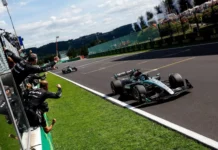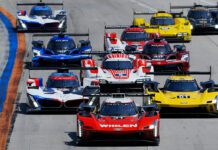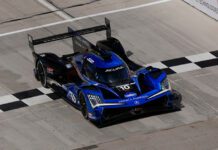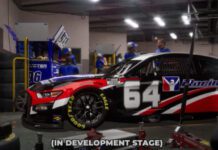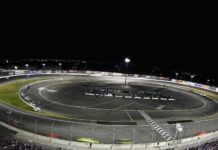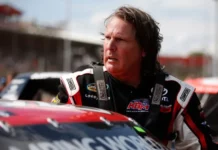A NASCAR executive said Tuesday that it was clear Ross Chastain committed a violation at the end of last weekend’s Cup race at the Indianapolis Motor Speedway road course, but series officials will look at ways they can issue the penalty quicker to avoid a situation where a car that has committed an infraction is racing for the lead.
Elton Sawyer, NASCAR vice president of officiating and technical inspection, made the comments on “The Morning Drive” on SiriusXM NASCAR Radio.
On the overtime restart, Chastain was on the far outside heading into Turn 1, a right-hand corner. With three cars to his right, Chastain chose to drove straight on to the escape route. He was fifth at the time and emerged on track next to Tyler Reddick, who was leading.
While Chastain gained four spots, some of that was because the field got jumbled in Turn 1. Cars running second, third and fourth entered Turn 1 side-by-side and shot up the track. Ryan Blaney, running fourth, was spun in Turn 2. His car blocked the lower lane and slowed cars on the outside.
Reddick later said he was uncertain if Chastain would be penalized or if he was racing Chastain for the win. As they dueled, Austin Cindric closed on the two. Reddick eventually got by Chastain and won the race without incident.
Asked on SiriusXM NASCAR Radio by NBC Sports’ Nate Ryan about if NASCAR could have made that call quicker, Sawyer responded: “I would answer that with a short one-word yes.
“We will start today with our debriefing of the event, the things we did well, the things we didn’t do so well, and the things we need to do better going forward.
“Track limits on those type of courses are always a challenge for us. We want to get it right. When those situations are presented to us, we go back to replay. Just remember we’re running a race. There’s still competition going on. We have a situation, we look at replay. That doesn’t happen in 10 seconds. We want to get it right. We want to make the right call. That’s why the rules are written the way they are.”
Sunday’s ending was similar to last year’s finish when Chase Briscoe went off course in Turn 1 on the final restart. He cut across the grass and was side-by-side with Denny Hamlin for the lead. Hamlin got by and Briscoe.
NASCAR announced the penalty just seconds before Briscoe, unaware he was being penalized, turned Hamlin. With Briscoe penalized, that meant AJ Allmendinger, who had been third on course was the leader. Allmendinger went on to win.
That situation could have been repeated with Chastain and Reddick but they didn’t make contact in their duel.
“Fortunately it didn’t happen as it did last year,” Sawyer said on SiriusXM NASCAR Radio. “We’re glad of that. We’ll continue to look at what we can do to try to eliminate those situations even being an opportunity for the drivers.
“We want to make sure that we give them a run-off area. In the past we’ve had tires or a barrier up there and that doesn’t fall into a very safe situation the run-off area. … Yes, we will look at what we can do internally to asses that penalty quicker, but the No. 1 thing is we want to get it right.”
Sawyer also explained why Chastain was penalized.
“It states right in (the track limit guidelines) that if you cut off a significant amount of the race course, then there will be a penalty,” Sawyer said. “If it is at the end of the race, it will be 30 seconds (added to the driver’s time). All of those bullet points, if you will, were well communicated to the industry, to the garage to the drivers.
“So what happened there at the end there, obviously the restart and they go off into Turn 1 and they get four- or five-wide. Ross, you can go back and look through the optics of it and you can also look at the data, he really accelerated. He didn’t (decelerate). He accelerated to go through the run-off area. Again, we explained, and felt like we explained it really well on what you can and can’t do and what we expect from the track limits.”
Asked by Ryan if drivers could use the access road if they missed Turn 1 but when they blended back to the track they could not gain any ground, Sawyer said: “Absolutely.
“Again, you can’t cut a significant amount of the course off and gain an advantage. When Ross came back out, he’s side-by-side with the leader, and they went off in the corner and he’s fifth. Just simply put, you can’t do that. That area is there for the reason — if you get into a bad spot and you can’t make the turn, i.e. you’ve had a brake failure, you’ve got in there too hot for whatever reason — you can run off there, but that’s not to be used to gain advantage.
“Obviously it was. If (Chastain) comes off the run-off area and he blends in somewhere about where he was running or fifth, sixth, eighth, 10th or that area, no harm, no foul. If we allowed that to happen … that would be come the normal line around the race course.”
After the race, Chastain said he thought he had acted properly since he was unable to make the corner and used the access road.
“The way I understand it is if you cut (the corner) and don’t take the access lane and you you re-emerge (on track) don’t gain any ground,” Chastain said. “I took their access lane. If I misunderstood their rule … I realized there was no way we’re making Turn 1, I can’t turn in, I’m going to be in the grass. So I took the alternative.
Chastain crossed the finish line second but was given 27th after the penalty.
“It’s their call,” Chastain said of NASCAR. “It’s their sandbox. They say we have a penalty, we have a penalty. I thought I knew the rule, though. I thought that I abided by the rule.
“I didn’t do it maliciously. I didn’t do it preemptively. We hadn’t planned for that. With three cars to my right and everybody running into each other and I was turning in, I couldn’t see how we would make it and I was going to be in the grass.”







